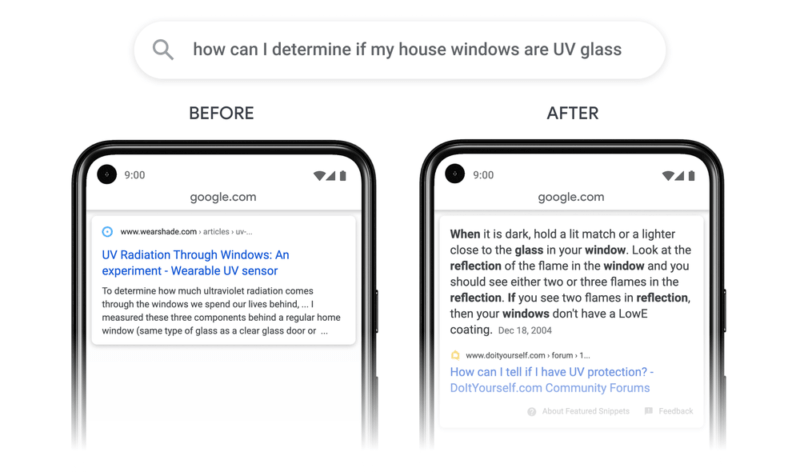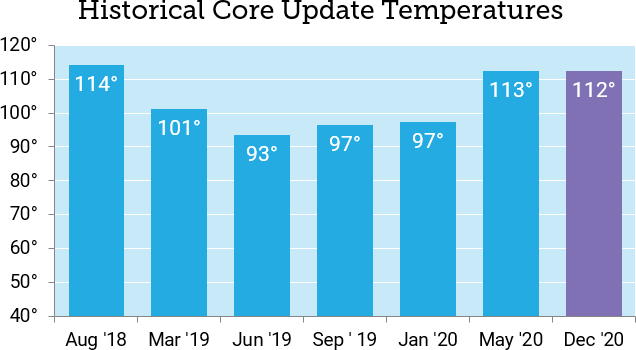Welcome to 2021!
Google surprised a lot of SEOs by releasing a core update between Thanksgiving and Christmas. Let us have a look back at this update and some other important news from Google in the last quarter of a year that we may otherwise want to forget.
Also a few announcements of things to come from your favorite search engine.
Passage indexing
In the “Google Presents: Search on 2020” video released in October Google announced and demonstrated an interesting new feature for search results called “passage indexing.” This new feature will allow Google to rank parts of pages as opposed to whole pages. The example given is where a long forum thread contains a great reply to the question, “How to tell if I have windows with UV protection.” Before passage indexing, this page would not feature in the search results because much of the page’s content does not reply to the question and sending a user to the top of the page will not help them find the answer to their question.
To provide the best answer, Google has found the solution to rank passages and provide a link to that passage in the page using anchor links that will take users straight to the relevant passage. You will see these anchor links as #:~:text in URLs.

This will also work in long blog articles, beyond using H2, H3 tags subtitles correctly there is nothing special you need to do to benefit from this feature. It has rolled out for English searches already and should be implemented for other languages in 2021.
Death of the Webmaster
On November 11th, Google Webmasters blog rebranded as Google Search Central. In this article, Google explained that they felt that the rebranding of Google Webmaster Tools and now the Google Webmasters blog was necessary because “Webmaster” was no longer used. Whereas many people could identify with this term 20 years ago, targeted web professionals now call themselves Search Engine Optimizer (SEO), online marketer, blogger, web developer, or site owner.
The relaunch has also seen a lot of content moved over to Search Central and much of it is localized into 13 languages.
The article announcing the death of Google Webmasters also announced the birth of a new spider sidekick for the Googlebot mascot.

Core Web Vitals update
Announced in May 2020, Core Web Vitals are the new measurement for page experience that Google will use as a ranking factor alongside existing factors such as mobile-friendliness, safe-browsing, HTTPS-security, and not using intrusive interstitials.
In a new blog post Timing for bringing page experience to Google Search, published in November Google gave more details of page experience ranking factors including the May 2021 launch date.
Core Web Vitals score for webpage performance using data collected by the Chrome browser. You can find your scores, page by page, using PageSpeed Insights (also available in SEOPress PRO) and Search Console’s Core Web Vitals report.
Google adds that they plan to test a visual indicator to highlight pages in search results that have great page experience. This may be tested before May 2021. Obtaining this badge may well increase traffic to your website so it’s important to start looking at Core Web Vitals and improving your score.
December Core Update
After Core Updates in January and May, and no update before the Summer holidays, many were expecting another major update to Google’s algorithm before the end of the year. But they breathed a sigh of relief once Black Friday and Thanksgiving had passed because we have learned to expect Google to launch updates before their own staff leave for vacation.
There was a lot of surprise then that a new, fairly big update was announced December 4th with effects (in terms of page rank) happening over a 2-week period.
The actual content of these updates is not divulged by Google but this article stresses that sites losing out should look at the quality of their content and their expertise in comparison with other pages featuring in the search engines.

While many commentators indicated that this was the biggest of the years’ three updates, Moz analyzed results and concluded that May’s update had been as big. However, in terms of the volatility of search results May and December were on a par with the 2018 Medic update.
Marie Haynes suggested in her Search Engine Land contribution, that the December update may be linked to some of the other topics discussed in this article: passage indexing and page experience. With also a possible nuance in the restrictions set up by Google for alternative medical content in past updates.
To check and improve the quality of your websites, have a look at our recommendation for Optimizing WordPress sites for Google EAT.
Back to work in September
Google staff – some 200,000 full-time and contract employees – have been working remotely since March 2020.
They are not expecting to start work from the office until September 2021 and this may be through a hybrid model allowing Googlers to work from home a few days a week.
As for many tech companies, staff are actually enjoying remote working and may find it difficult to go back to homes that are close enough to commute from when some office hours are required.
Google in 2020 in Review
This article completes a series of quarterly reviews of Google Updates. See the review of quarters 1, 2 and 3 here:



